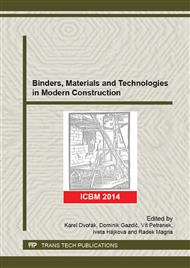p.73
p.81
p.87
p.91
p.97
p.101
p.106
p.112
p.116
Thermal Insulation Plasters Utilising Natural Fibres
Abstract:
Natural fibres have been used in plaster reinforcement throughout history. The paper deals with the development of natural fibre reinforced thermal insulation plasters. Given the ongoing research in plaster mixes, there was an effort to develop thermal insulation plasters utilising not only alternative binders but also natural fibres produced in farming. Fibres were both of plant as well as animal origin. The goal of this development of the natural fibre reinforced thermal insulation plasters was to design materials with reduced energy costs, suitable for insulation and rehabilitation of buildings and with good physical, mechanical and thermal insulation properties. Furthermore, thanks to the use of alternative binders and natural fibres, these plasters can be considered environmentally friendly.
Info:
Periodical:
Pages:
97-100
Citation:
Online since:
April 2015
Authors:
Price:
Сopyright:
© 2015 Trans Tech Publications Ltd. All Rights Reserved
Share:
Citation:


